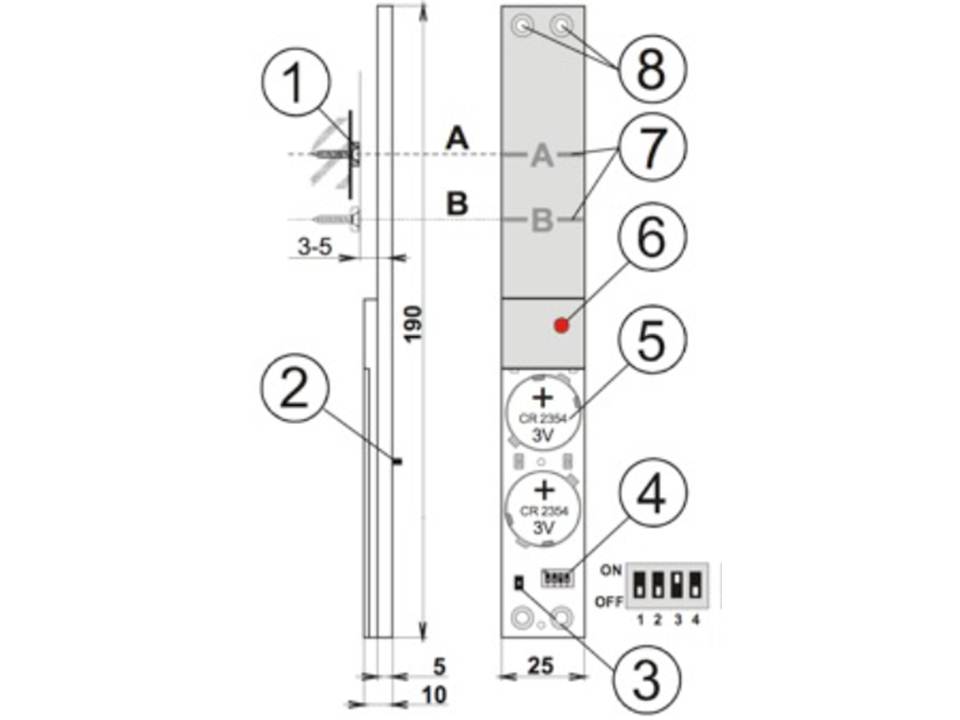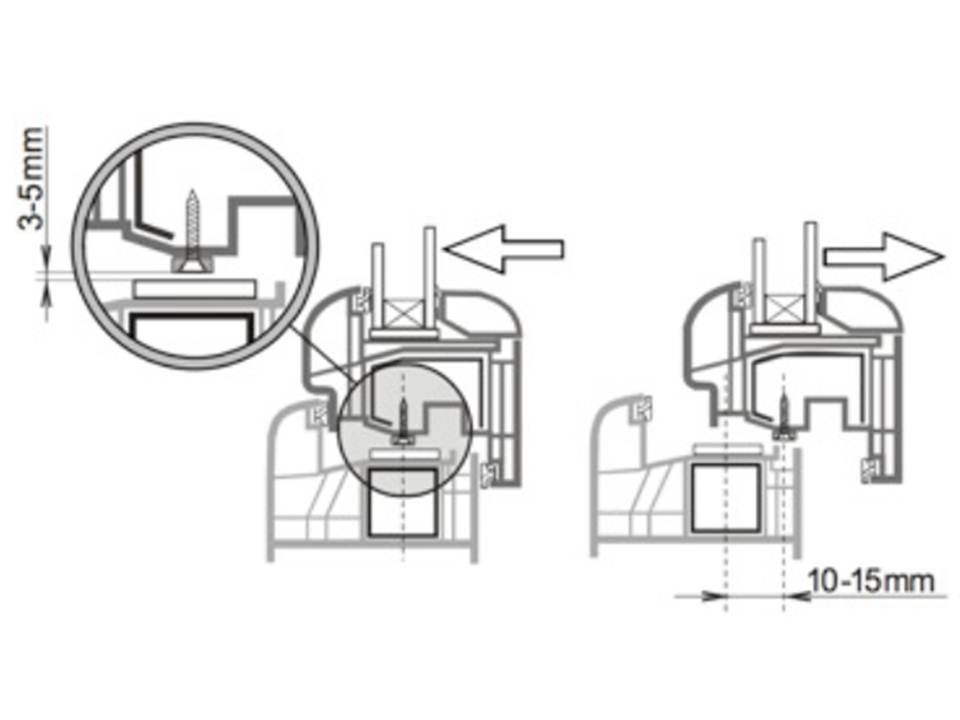JA-82M
There are no products in these categories. Shop on.

Service instructions for JA-82M
1 Installation

1. magnet, 2. rear tamper sensors, 3. tamper sensor valve, 4. DIP switches, 5. battery, 6. LED indicator, 7. fitting strips, 8. screw holes.
LED indicator - 15 minutes after closing the battery cover, the LED
indicates the triggering of the detector (a flashing light indicates the opening of a window, a long light indicates that both tamper sensors have been triggered).
1. Find a suitable location for the detector so that the magnet faces the A (or B)
when the window or door is closed.
2. Avoid placing the detector directly on a metal surface because metal can affect the
operation of the magnetic sensor and radio communication. This can
usually be achieved by placing the detector on the hanging side of the window or door
. Furthermore, avoid installing the detector at the bottom of the frame
of the window or door due to possible condensation water
3. Screw the magnet onto the moving part of the window according to the following drawing.
Use a non-metallic mounting plate if the space in the frame is too large.
4. Unscrew the battery cover and screw the detector so that the magnet falls against
over the A (or B) line when the window or door is closed. See the drawing. Be
cautious and do not use too much force when tightening the detector otherwise the
plastic housing may be damaged.
5. You can use the supplied long plastic strips to ensure that the
place where the detector is to be fixed is sufficiently flat. After the detector
has been installed, at least one rear sabotage detector should be permanently
closed (depressed).
6. Carefully try whether the detector (magnet) does not form an obstacle when closing the
window or door.
7. If everything is OK, the functionality of the detector can be configured (See
DIP switches below).
8. Enter login mode on the central controller (or on a receiver). Then insert the
button cell batteries into the detector and screw the cover in place (2 screws). After
connecting the battery, the detector will automatically send a login signal. Up to
10 seconds delay should be expected regarding the response of the
detector to removing the magnet, closing or pressing and releasing the
sabotage sensors.
9. After the detector is registered, you can check its operation. On the Jablotron OASiS
central unit, you should also check the signal strength.
DIP switches
| Nummer | Uit | Aan |
| 1 | Sabotage sensors rear off | Sabotage sensors rear on* |
| 2 | Permanent status display window/door | Display open window/door only** |
| 3*** | The system provides input and output delay | The system responds with instantaneous alarm |
| 4 | No function | No function |
The default settings are in bold
*To detect intrusion, it must be set to ON.
** Switching ON is suitable for bedrooms, where windows and doors are left open for ventilation at the time the central unit is switched on.
***This setting applies if the detector is used with an OASiS central unit
with a pre-programmed natural response for the address of the detector.
2 Testing the detector
Up to 15 minutes after closing the detector's cover, the LED displays the triggering of the detector as follows:
Short flash - air pressure change (deformation of glass)
Long flash - glass breakage detection (alarm)
Adjusting the sensor
- By using proper tools or by using a hand that is
protected with a glove, knock one by one on all the windows that
should be protected by the detector. A visible deformation of the glass should happen without causing damage.
- The deformation of the glass causes a change in the air pressure in the room that causes the detector's LED to flash briefly.
- The sensitivity to air pressure can be adjusted using the potentiometer on the
PCB. Turning counter-clockwise increases the sensitivity. Avoid choosing too high a sensitivity as this may cause a short battery life.
- The complete operation of the detector can be tested with a GBT-212 glass breakage simulator. After tapping on the glass, the simulator will automatically make a characteristic sound of breaking to trigger the detector.
3 Replacing battery
The batteries of the detector are checked regularly. If the battery voltage becomes too low then the installer or user is informed. The detector continues to function however replacing the batteries should not be delayed more than 2 weeks. Always replace both batteries. We recommend that you use batteries of a highly qualified with (e.g. Panasonic). After the batteries have been replaced, the detector's operation should be tested.
Old batteries should not be thrown in the dustbin, but disposed of according to the local applicable regulations.
4 Removing the detector from the system
When a detector is removed, the central controller reports the removal. The detector should first be removed in the central unit if the intention is to physically remove it.
5 Technical parameters
| Spanning: | Lithium battery type CR2354-2 pieces (3.0V, 1 Ah) power supply type C |
| Estimated battery life: | About 3 years (if activated 5 times daily) |
| Communicatieband: | 868 MHz, OASiS protocol |
| Communicatiebereik: | About 200m (in open field) |
| Afmetingen: | 192 x 25 x 9 mm |
| Temperatuurbereik: | -10 to +40 °C |
| Classification grade 2 according to: | EN 50131-1, EN 50131-2-6, EN 50131-5-3 |
| Voldoet aan: | ETSI EN 300220, EN50131-2-6, EN 60950 -1 |
| Can be operated in accordance with: | ERC REC 70-03 FCC ID VL6JA82M |
Werkingsgebied volgens EN 50131-1 II. interne ruimte
